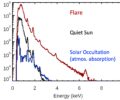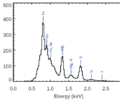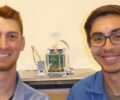News
MinXSS v4.0.0 and DAXSS v2.0.0 data released
It’s release day again! In addition to all the updates and improvements we’ve made to the data you’ve seen before, this is also the first official release of DAXSS level 2 and 3 data, which are 1 minute, 1 hour, and 1 day time averages of the data. INSPIRESat-1 (the satellite that hosts DAXSS) launched […]
(Read more»)INSPIRESat-1/DAXSS data release version 2.0 and new python analysis tools
The Miniature X-Ray Solar Spectrometer 3, or MinXSS-3, successfully launched on the INSPIRESat-1small satellite on February 14, 2022 on the Indian Space Research Organization’s Polar Satellite LaunchVehicle (PSLV-C52). Also known as the Dual Aperture X-ray Solar Spectrometer, or DAXSS, MinXSS-3 isthe third in the series of NASA-funded MinXSS instruments. DAXSS observes the solar soft X-ray […]
(Read more»)INSPIRESat-1/DAXSS (AKA MinXSS-3) Level 1 data available
INSPIRESat-1 launched on 2022-02-14 into a sun-synchronous, dawn-dusk orbit. That means that it almost never experiences orbit eclipse and therefore has an almost entirely uninterrupted view of the sun. Even in the <4 months since launch, hundreds of solar flares have been observed. Not all of the DAXSS data for them have been downlinked yet, […]
(Read more»)MinXSS-3 (INSPIRESat-1) first light!
Just a couple weeks after deployment, we’ve been able to turn on the Dual-zone Aperture X-ray Solar Spectrometer (DAXSS), the upgraded successor to the primary instrument on MinXSS. DAXSS has high dynamic range due to dual-zone aperture (which we published about here) as well as improved energy resolution. That improvement is what you can see […]
(Read more»)INSPIRESat-1/MinXSS-3 launched and working!
The launch occurred right on time and without a hitch! INSPIRESat-1 was deployed at 2022-02-14 00:47:31.5 UT into the planned polar orbit, circling the world right along the “terminator”, that 6 AM/6PM time that is always in the sun. Here is one of the many stories that have been published about the mission, this one […]
(Read more»)


